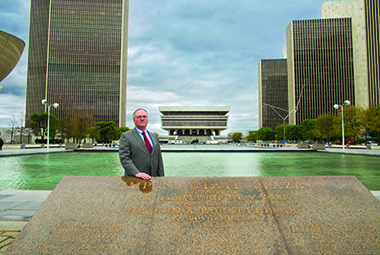The Human Face of Urban Renewal
.jpg) |
|
Two shots from David Hochfelder's visual history of urban renewal depict a Lower East Side neighborhood before it was demolished to make way for the Stuyvesant Town project after WW2. At left are the Williams Furniture and Liberal Loans stores on 1st Avenue and 15th Street, and at right a resident reads a notice about a public meeting to save the neighborhood in the window of Williams Furniture. (Photos courtesy of the MetLife Archives.)
|
ALBANY, N.Y. (Aug. 22, 2018) — A well-intentioned effort to end urban decay, urban renewal in the United States mixed successes with instances of lost neighborhoods, historic structures and access to waterfronts, as well as the displacement of millions of families.
David Hochfelder, associate professor of History, is giving voice to lives affected by urban renewal in a digital visual look at the program’s impact upon four New York cities — a project newly supported by a grant from the National Endowment for the Humanities (NEH).
Picturing Urban Renewal was awarded by the NEH in its final round of funding for 2018. Hochfelder’s grant comes in the Digital Humanities Advancement category and supports his development of an interactive website that, through historic photographs and drawings, will explore the results of urban renewal in Albany, Kingston, Newburgh and New York City's Lower East Side.
“We're excited to begin work next month,” said Hochfelder, whose current project is an outgrowth of his 98 Acres in Albany, a social history of urban renewal in Albany that employed rich photographic record, public outreach and oral histories, as well as traditional archival research, to document the experiences of residents, business owners, construction workers and others whose lives were affected by the demolition and construction of the Empire State Plaza.
 |
|
Historian David Hochfelder stands at the Empire State Plaza, whose construction eliminated several distinct neighborhoods in downtown Albany when it seized 98 acres of the city in 1962. (Photo by Paul Miller) |
Picturing Urban Renewal will place in space and time historic photographs of major redevelopment projects in the four New York cities. The project makes two key contributions to urban and public history:
- By focusing on the visual record, particularly pre-demolition and construction-era photographs, it will place in the foreground the human experience of redevelopment.
- By comparing the impact of urban renewal on cities of varying sizes and economic fortunes, it will fill an important gap in the scholarly literature, which emphasizes urban centers almost to the exclusion of the small and mid-sized towns and cities.
“A major need for this work arises from the simple fact that nobody actually knows how much land around the country was seized for urban renewal, how many families displaced, how many buildings torn down, etc.,” Hochfelder said. “We think this website will be a resource for other cities still coming to terms with the impact of urban renewal.”
The NEH award is a Level 1 planning grant will allow Hochfelder to design, plan and prototype for the website. In time, the project may expand to include other cities.
Other projects include a book of photo essays on 98 Acres in Albany, for which Hochfelder has a book contract from SUNY Press, and a place-based, people-centered, responsive website that would explore how urban renewal transformed Albany. He has applied for a Discovery level Digital Projects for the Public grant from NEH to support the prototyping phase.
In collaboration with the State Archives, he also applied in July for an NEH Humanities Collections and Reference Resources grant in order to “inventory, catalog, select and digitize selected urban renewal documents from about 80 municipalities around the State of New York
![]() For more news, subscribe to UAlbany's RSS headline feeds
For more news, subscribe to UAlbany's RSS headline feeds
A comprehensive public research university, the University at Albany-SUNY offers more than 120 undergraduate majors and minors and 125 master's, doctoral and graduate certificate programs. UAlbany is a leader among all New York State colleges and universities in such diverse fields as atmospheric and environmental sciences, business, education, public health,health sciences, criminal justice, emergency preparedness, engineering and applied sciences, informatics, public administration, social welfare and sociology, taught by an extensive roster of faculty experts. It also offers expanded academic and research opportunities for students through an affiliation with Albany Law School. With a curriculum enhanced by 600 study-abroad opportunities, UAlbany launches great careers.


